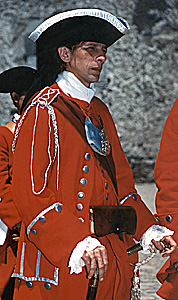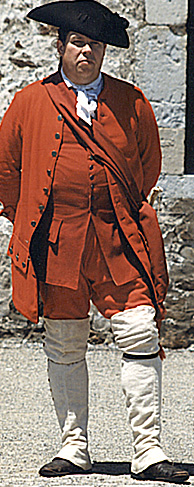 During the American Revolution Fort Niagara was a base camp for Iroquois
Indian raids that reached far into the interior of New York and
Pennsylvania. The Americans had never really contemplated a direct assault
on the fort so it became a stronghold and staging area for Indian attacks
on the Americans.
During the American Revolution Fort Niagara was a base camp for Iroquois
Indian raids that reached far into the interior of New York and
Pennsylvania. The Americans had never really contemplated a direct assault
on the fort so it became a stronghold and staging area for Indian attacks
on the Americans.
It should be noted that Fort Niagara's commander just before the American Revolution began was general Gage who was placed in charge of the defense of Boston when hostilities began. During Gage's command the garrison was actually under the command of a Lt. Colonel Smith while Gage was elsewhere. The regiment, the 10th, in 1774 also left for Boston and took part in the march on Concord.
During the American Revolution the fort was surrounded by a large Indian encampment. As a part of the war of terror waged against the Americans the Indians of New York relied on the fort for supplies. The Americans did launch a massive attack on the Iroquois Indians that lived in central New York further increasing the reliance of the Indians on the fort as a haven.
After the Sullivan campaign of 1779 the Indians cashed in on the original promise made by the French that the fort would be a "house of peace" but not plenty. These refugees made camped in the ditches of the outer works and many died there from starvation during the harsh winter months. Their bodies were covered with lime and then earth creating a huge mass grave.
 The promise made by the French and kept by the British would be short lived
as eventually the fort and its environs would be turned over to the
Americans in 1796. The Indians who fought so hard to destroy the Americans
were now at their mercy.
The promise made by the French and kept by the British would be short lived
as eventually the fort and its environs would be turned over to the
Americans in 1796. The Indians who fought so hard to destroy the Americans
were now at their mercy.
The closing years of the 18th century found the fort in American hands until the War of 1812. In the mean time the British to secure their Canadian holdings built or rebuilt two other forts along the British side of the Niagara River. In Buffalo there was the restored Fort Erie. Up stream from Fort Niagara was Fort George which would exchange artillery fire with the American Fort Niagara.
Later in 1814, within literal site of the American fort was Fort Missiasauga which now sits in silence on the 18th hole of a golf course. During the War of 1812 the Americans had removed the roofs of the redoubts and the Mess or French Castle. The now exposed top floor of the Mess provided a gun platform for American batteries that exchanged fire with Fort George some 1340 yards across the Niagara River. In December 1813 saw the capture of Fort Niagara by the British. After the war the fort was again returned to the Americans.
 The next 70 years at Fort Niagara saw more change. During this time the
parade ground in the middle of the fort saw buildings come and go through
fire and disrepair. The establishment of the Erie Canal decreased the
importance of the Niagara River as a prominent water route. The fort in
1826 did receive some attention with the "Know Nothing Party" activities.
The next 70 years at Fort Niagara saw more change. During this time the
parade ground in the middle of the fort saw buildings come and go through
fire and disrepair. The establishment of the Erie Canal decreased the
importance of the Niagara River as a prominent water route. The fort in
1826 did receive some attention with the "Know Nothing Party" activities.
A free Mason, Bill Morgan, of some import was arrested and placed a prisoner in the old French powder magazine. Before the local police could intervene he mysteriously disappeared. America was moving further west than Niagara. The garrison would fluctuate constantly. In the 1830's the river side walls of the fort were rebuilt utilizing stone instead of wood. A postern gate had been here since the time of the French and this lead to the shore where boats could be landed. Also a hot shot oven was built for use by a battery placed along the new wall.
American Civil War
The American Civil War breathed new life into the fort with the threat of a British invasion out of Canada. The old horn works were improved with the addition of brick casemates being completed in 1871. These casemates were extensive and even covered the old entrance once gained through the now gone drawbridge which had not been used since 1805. These would remain intact until the restoration of the 1920's when the drawbridge was reopened and the casemates were reduced. Batteries were placed along both the river side and lake side of the fort. But war never came and eventually the garrison removed for all intents and purposes.
The Spanish American War saw a renewed activity by the US Army at the fort which for military purposes utilized the grounds around the old fort. The old fort was still occupied in various ways such as storage. Camps were established and buildings of brick were erected. Some of these still exist and are in use by the State Parks and private organizations headquartered there. With the end of the century the fort resumed peacetime quiet. The old fort provided housing for people associated with the military activities at the new fort outside the old walls.
By the 1890s photographs of the old fort show no barracks blocks or other buildings that once surrounded the parade ground. Over the previous 200 years there had probably been 200 or more various buildings in this area but now they were all gone. The French Castle or Officers Mess rests in these photographs porched, whitewashed and almost dormerless. But the core of the first French trading house, the powder magazine, the storehouse and the British redoubts remained with curious vacationers roaming the grounds.
 20th Century
20th Century
The twentieth century for Fort Niagara was a time of even greater change. The elements were beginning to take their toll on the old fort. Originally the fort grounds had reached three hundred feet beyond the "House of Peace", slowly erosion by the river had reduced the area behind the castle to perhaps 15 feet or less. The French had begun the practice shore preservation and all succeeding occupants to this day have continued the work. It is possible that this is the oldest and longest reclamation project ever taken on in the United States.
At one point the riverside sea wall collapsed threatening to destroy the French castle casing a fracture in its walls. Temporary repairs were made and these eventually lead to the restoration project began by the Old Fort Niagara Association in 1927.
So ends this brief history of the Old Fort. In the First World War the New Fort Niagara was a training base. During World War Two New Fort Niagara became a training base and prison camp. The New Fort was officially closed in the 1960's. But the Old Fort has been restored to much of its original condition and is a valuable historic site deeded to New York State but under the care and direction of the Old Fort Niagara Association.
More Old Fort Niagara
-
Old Fort Niagara Introduction
Forts Conti and Denonville (slow: 175K)
Siege of Fort Niagara during the French and Indian War (slow: 200K)
American Revolution and War of 1812 (slow: 263K)
A Brief Tour of the Existing Buildings (75K)
Conclusion and Contacts (slow: 187K)
Bookstore Buys
Re-enactors and Fort George Photos (very slow: 408K)
Pre-renovation: 1926 Photos (very slow: 268K)
1909 Postcard of Old Fort Niagara (slow: 165K)
Back to List of Battlefields
Back to Travel Master List
Back to MagWeb Master List of Magazines
© Copyright 1997 by Coalition Web, Inc.
This article appears in MagWeb (Magazine Web) on the Internet World Wide Web.
Other military history articles and gaming articles are available at http://www.magweb.com